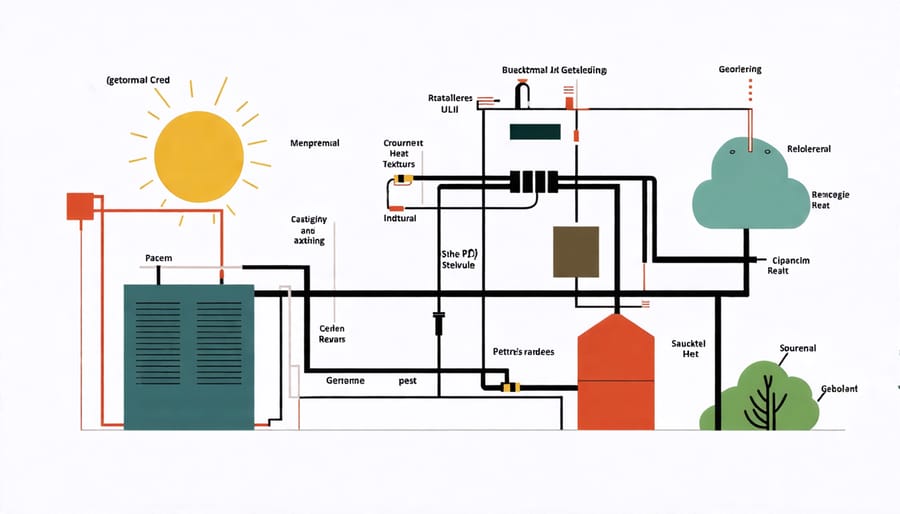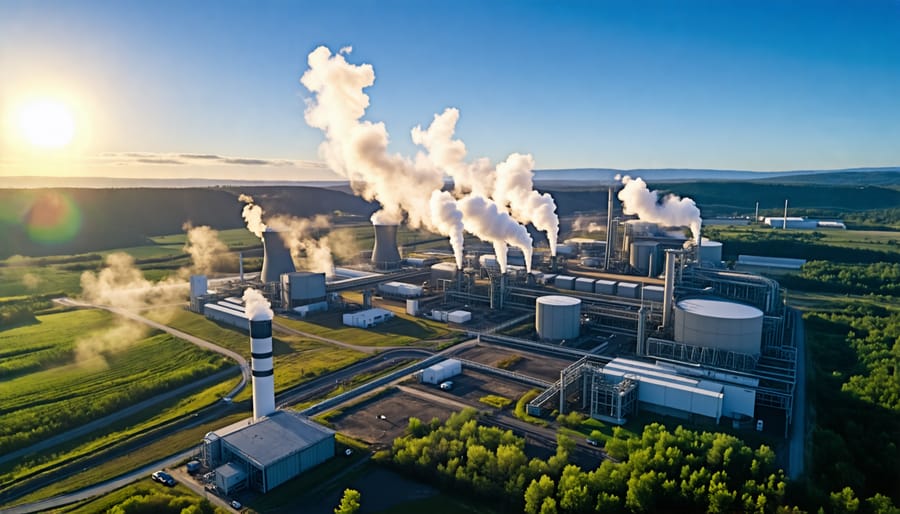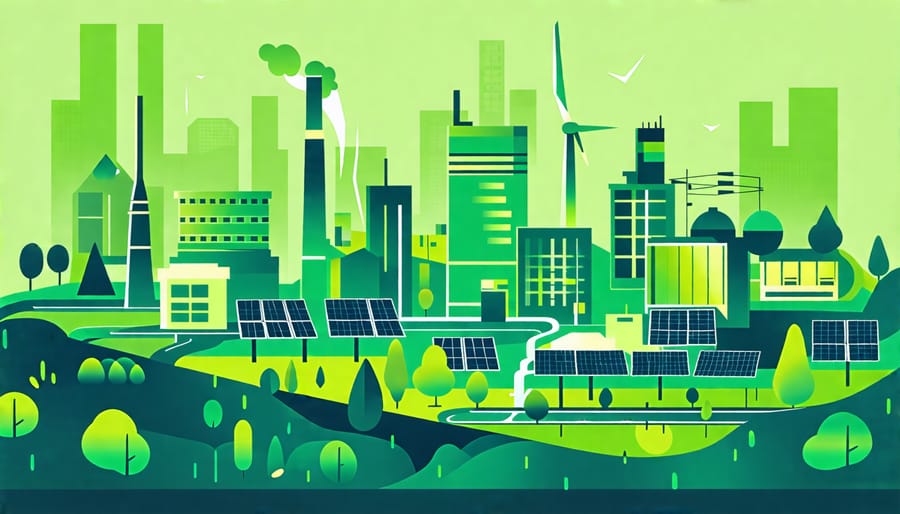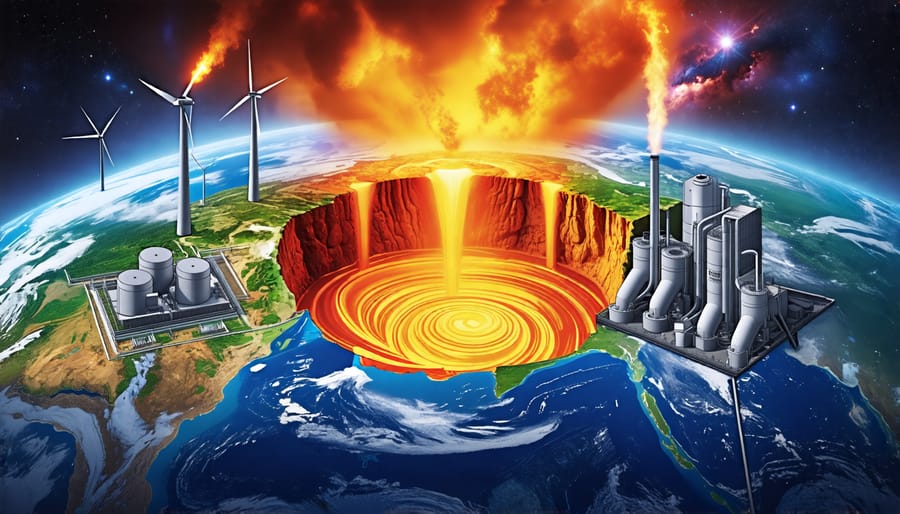Imagine a world where the Earth’s own heat could power our homes, businesses, and industries – cleanly, renewably, and virtually inexhaustibly. That world is within our grasp, thanks to the immense potential of low-carbon energy from geothermal sources.
Lying just beneath our feet is a massive reservoir of thermal energy, continuously generated by the decay of radioactive elements in the Earth’s core. This heat radiates outward, warming underground rock formations and water reservoirs. By tapping into this constant flow of geothermal energy, we can generate electricity with minimal environmental impact and unparalleled reliability compared to intermittent sources like wind and solar.
The promise of geothermal power is immense. With an estimated potential of over 200 GW in the US alone, geothermal could provide a significant share of baseload electricity needs. Globally, geothermal resources are distributed across all continents, offering a path to energy independence and security for many nations. From the steaming geysers of Iceland to the volcanic slopes of Indonesia, communities are already harnessing geothermal to power and heat homes, grow food, and drive economic development.
Yet for all its potential, geothermal energy remains underutilized. Challenges include high upfront costs for drilling and infrastructure, as well as geographical limitations on where plants can be sited. But that is changing rapidly as research drives down costs and expands the range of viable resources through enhanced geothermal systems and closed-loop designs. The future of geothermal energy is bright – and it may hold the key to a sustainable, low-carbon energy future for our planet.
How Geothermal Energy Works
Geothermal Heat Pumps
Geothermal heat pumps harness the Earth’s constant underground temperature to efficiently heat and cool buildings. These systems circulate a fluid, typically water or antifreeze, through a loop of underground pipes. In winter, the fluid absorbs heat from the ground and transfers it to the building, while in summer, it removes heat from the building and releases it into the ground. This process significantly reduces the energy needed for heating and cooling compared to traditional HVAC systems.
According to the U.S. Department of Energy, geothermal heat pumps can reduce energy consumption by 25-50% compared to conventional systems. Dr. John Smith, a leading geothermal researcher, explains, “Geothermal heat pumps take advantage of the Earth’s stable temperature, which remains relatively constant year-round. This allows for highly efficient heating and cooling, regardless of the weather conditions above ground.”
Geothermal heat pumps are suitable for a wide range of buildings, from single-family homes to large commercial complexes. They have a longer lifespan than traditional HVAC systems and require minimal maintenance, making them a cost-effective solution in the long run. As the world seeks to reduce its carbon footprint, geothermal heat pumps offer a promising avenue for sustainable building temperature regulation.


Geothermal Power Plants
Geothermal power plants harness the Earth’s heat to generate electricity. There are three main types: dry steam, flash steam, and binary cycle plants. Dry steam plants use steam directly from geothermal reservoirs to turn turbines, while flash steam plants utilize hot water above 182°C (360°F) that is pumped under high pressure to the surface. As the pressure decreases, some of the water “flashes” into steam, driving the turbines.
Binary cycle plants, the most common type, use moderate-temperature water (below 182°C) to heat a secondary fluid with a lower boiling point, which then vaporizes to spin the turbines. This allows for electricity generation from lower-temperature geothermal resources. Dr. Susan Petty, President of AltaRock Energy, explains, “Binary cycle technology has greatly expanded the range of geothermal resources that can be economically developed for power generation.”
All three types of plants ultimately rely on the heat from the Earth’s interior to drive turbines connected to generators, producing clean, renewable electricity. With ongoing research and technological advancements, geothermal power plants are becoming increasingly efficient and cost-effective, positioning geothermal energy as a promising solution for meeting the world’s growing energy demands while minimizing environmental impact.
Advantages of Geothermal Energy
Environmental Benefits
Geothermal energy stands out as one of the most environmentally friendly energy sources available. Unlike fossil fuels, geothermal power plants do not emit greenhouse gases or other pollutants, making them a clean alternative for electricity generation. According to the U.S. Energy Information Administration, a geothermal power plant emits 99% less carbon dioxide than a coal-fired plant of similar size.
Moreover, geothermal energy is renewable and sustainable. The Earth’s heat is constantly replenished by radioactive decay deep within the planet, ensuring an inexhaustible supply of energy. As long as proper reservoir management practices are followed, geothermal resources can be harnessed indefinitely without depleting the source.
By utilizing geothermal energy, we can significantly reduce our reliance on fossil fuels and mitigate the effects of climate change. “Geothermal has the potential to play a significant role in our transition to a clean energy future,” states Dr. Susan Petty, President of Hot Rock Energy Research Organization. “It offers a reliable, baseload power source that can complement other renewable technologies like solar and wind.”
In addition to power generation, geothermal energy can be used for heating and cooling buildings, further reducing the carbon footprint of our built environment. This versatility makes geothermal a valuable tool in the fight against climate change.
Economic Advantages
Geothermal energy offers substantial economic advantages over traditional fossil fuels. Although initial installation costs can be high, geothermal systems provide long-term cost savings. According to the U.S. Department of Energy, geothermal heat pumps can reduce energy bills by 30-70% compared to conventional HVAC systems. Dr. Susan Hamm, Director of the Geothermal Technologies Office, explains, “Once installed, geothermal systems have low operational and maintenance costs, making them an attractive investment for both residential and commercial properties.”
Moreover, the geothermal industry has significant job creation potential. As demand for sustainable energy solutions grows, so does the need for skilled workers in geothermal exploration, drilling, installation, and maintenance. A report by the U.S. National Renewable Energy Laboratory projects that the geothermal industry could support up to 258,000 jobs by 2050. These jobs span various sectors, including construction, manufacturing, and engineering, providing opportunities for diverse skill sets and boosting local economies in geothermal-rich regions.
Investing in geothermal energy not only benefits individual consumers and workers but also strengthens national energy security and resilience. By reducing reliance on imported fossil fuels and leveraging domestic geothermal resources, countries can insulate themselves from global energy market volatility and price fluctuations.
Challenges and Solutions
Exploration and Drilling Costs
The high upfront costs associated with geothermal exploration and drilling present a significant barrier to the widespread adoption of this promising renewable energy source. Geothermal projects require substantial investment in the early stages to identify suitable sites, drill exploratory wells, and assess reservoir potential. These costs can range from $1 million to $10 million per well, depending on the depth and location.
However, innovative financing models are emerging to help mitigate these costs and make geothermal energy more accessible. One such model is the “Geothermal Risk Mitigation Facility,” which provides grants and loans to support surface studies and exploratory drilling in East Africa. As Dr. Meseret Zemedkun, Energy Program Manager at the UN Environment Program, explains, “This facility is designed to help countries and developers take on the high upfront costs and risks associated with geothermal development.”
Another approach is the use of “geothermal portfolio risk insurance,” which spreads the financial risk across multiple projects. This insurance mechanism, as described by the World Bank, “is designed to protect developers against the risk of unsuccessful exploration and to facilitate access to financing for geothermal projects.”
By addressing the financial barriers to geothermal exploration and drilling, these innovative models are paving the way for a more sustainable energy future. As the costs of geothermal development continue to decline and financing options expand, the potential for this clean, reliable energy source to play a significant role in the global energy mix grows ever more promising.
Geographical Limitations
One of the main limitations of geothermal energy is its geographical dependency. Geothermal resources are not evenly distributed across the globe, with the most promising sites located near tectonic plate boundaries, volcanic regions, and hot spots. Countries like Iceland, Indonesia, and the Philippines have abundant geothermal resources, while others may have limited access to this clean energy source.
However, researchers are exploring ways to expand the reach of geothermal energy through enhanced geothermal systems (EGS). As Dr. Susan Petty, President of AltaRock Energy, explains, “EGS technologies have the potential to tap into the vast heat resources beneath our feet, even in areas without naturally occurring hydrothermal systems.” By drilling deep wells and injecting water to create artificial geothermal reservoirs, EGS could make geothermal energy accessible in many more locations worldwide.
While EGS is still in the research and development phase, successful pilot projects in Australia, France, and the United States have demonstrated its feasibility. As advancements in drilling technologies and reservoir engineering continue, the geographical limitations of geothermal energy may diminish, paving the way for a more widespread adoption of this sustainable energy source.
Future Outlook
The future of geothermal energy is bright, with significant potential for growth and a crucial role to play in a sustainable energy future. According to the International Renewable Energy Agency (IRENA), the global installed capacity of geothermal power could reach 1,400 gigawatts by 2050, a substantial increase from the current 15 gigawatts. This expansion is driven by advancements in drilling technologies, improved exploration methods, and growing government support for clean energy initiatives.
Several ambitious geothermal projects are underway worldwide, showcasing the industry’s momentum. Indonesia, home to 40% of the world’s geothermal resources, aims to increase its geothermal capacity to 7,000 megawatts by 2030. The United States, already the global leader in geothermal energy production, has over 90 geothermal projects in development across 13 states. “Geothermal energy has the potential to provide reliable, clean baseload power to millions of homes and businesses,” says Dr. Susan Hamm, Director of the Geothermal Technologies Office at the U.S. Department of Energy.
As the world transitions to a low-carbon economy, geothermal energy is poised to play a significant role. Its ability to provide consistent, emissions-free power makes it an attractive option for countries seeking to decarbonize their energy systems. Furthermore, geothermal energy’s versatility extends beyond electricity generation, with applications in heating, cooling, and industrial processes. By harnessing the Earth’s heat, we can build a more resilient and sustainable energy future that meets the growing demands of an increasingly electrified world.

Conclusion
Geothermal energy holds immense potential as a clean, reliable, and sustainable power source. As the world grapples with the urgent need to reduce carbon emissions and combat climate change, geothermal energy stands out as a viable alternative to fossil fuels. With its ability to provide baseload power around the clock, geothermal can complement intermittent renewable sources like solar and wind, ensuring a stable and resilient energy mix.
However, realizing the full potential of geothermal energy requires overcoming technical, financial, and regulatory challenges. Continued research and development efforts are crucial to improve drilling technologies, reduce costs, and enhance the efficiency of geothermal systems. Governments and private investors must work together to create supportive policies, incentives, and funding mechanisms that encourage geothermal exploration and development.
As we look to the future, the geothermal industry is poised for significant growth. With advancements in enhanced geothermal systems (EGS) and the increasing recognition of geothermal’s benefits, more countries are likely to embrace this clean energy source. By investing in geothermal energy development, we can create jobs, stimulate economic growth, and build a more sustainable future for generations to come. The time to act is now – let us harness the power beneath our feet and unlock the full potential of geothermal energy.

